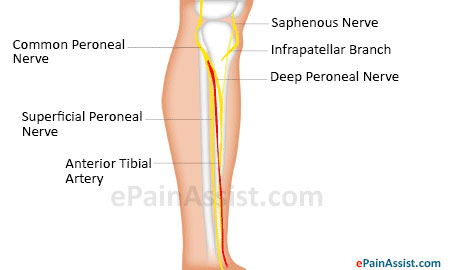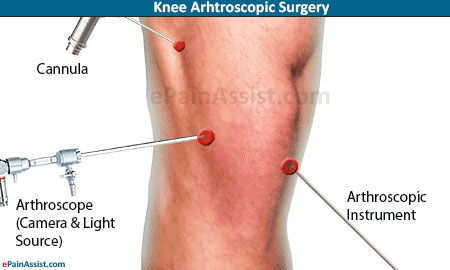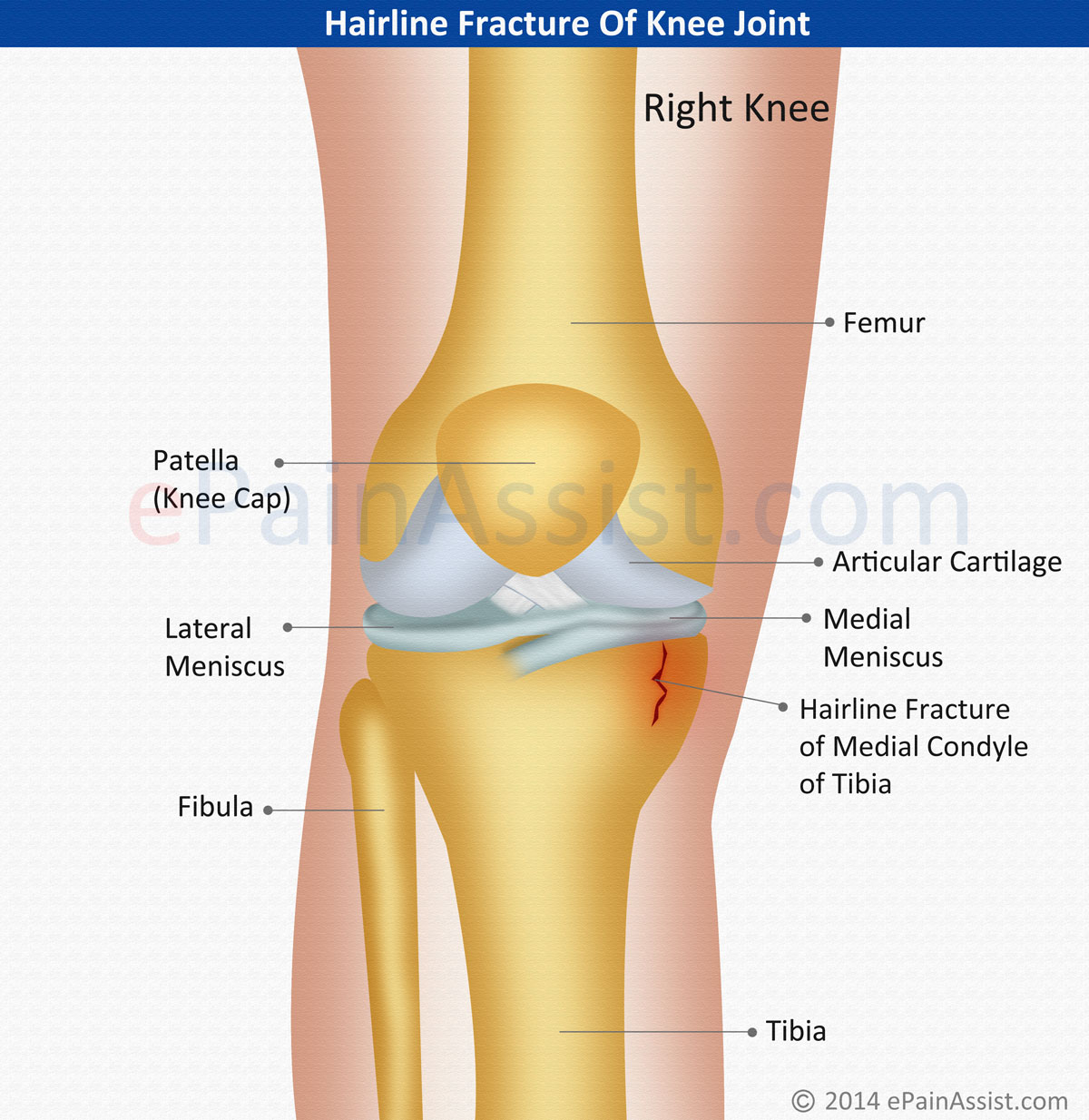Knee joint is the most used joint after shoulder joint in human body. Knee joint is formed by patella, tibia and femur. Knee joint fracture is either isolated fracture that involves one bone or multiple fractures, which involves patella, tibia and femur. Knee joint fracture includes intraarticular (within knee joint capsule) fracture or extension of extra articular fracture (outside knee joint) into knee joint.
Knee Joint Consists Of Following Two Joints-
- Patella-femoral joint and
- Tibio-femoral joint.
Bones Involved In Forming Of Knee Joint
- Patella (Knee Cap) 1
- Femur
- Medial (Inner) Supracondylar Fracture
- Lateral (Outer) Supracondylar Fracture
- Inter-Condylar Fracture
- Tibia
- Medial (Inner) Supracondylar Fracture
- Lateral (Outer) Supracondylar Fracture
- Inter-Condylar Fracture
Classification and Types Of Knee Joint Fracture
1. Hairline Fracture Of Knee Joint
- Hairline Fracture or crack is mostly on the surface of the bone and does not pass through entire thickness of the bone.
- Fracture or crack does not spread through complete circumference of patella, femur or tibia, but covers partial circumference of the bone.
- Hairline fracture is treated with conservative treatment.
2. Non-Displaced Fracture Of Knee Joint
- Fracture or cracks passes through entire thickness of the bone.
- Fracture fragment maintains normal anatomical position following injury.
- Fracture fragment maintains normal anatomical position during conservative treatment, which may involve closed reduction and application of braces or cast.
- Treated with conservative treatment.
3. Partial Displaced Fracture Of Knee Joint
- Fracture or cracks passes through entire thickness of the bone just like stable partial displaced fracture.
- Fractured fragment is partially displaced away from parent bone.
- Isolated piece of fracture segment is partially displaced from normal anatomical position.
- Fractured fragment maintains normal anatomical position following conservative treatment and close reduction.
- Treated with close reduction.
- Surgical treatment is advised when close reduction and external fixator treatment fails to reduce the fracture.
4. Complete Displaced Fracture Of Knee Joint
- Fracture or cracks passes through entire thickness of the bone just like stable non-displace fracture.
- Fracture fragment is an isolated piece of bone, which is separated from parent bone.
- Fracture fragment does not maintain normal anatomical position.
- Close reduction often fails to bring the displaced segment of fracture bone to normal anatomical position.
- Treated with surgical treatments and medications.

5. Compound (Open) Knee Joint Fracture
- Fracture fragment is completely displaced
- Parent bone or fracture fragment protrudes through skin and subcutaneous tissue and exposed to atmosphere.
- Fracture is associated with loss of covering skin, subcutaneous tissue and muscles.
- Bones are exposed to atmosphere.
- Associated with extensive tissue damage.
- Fracture is associated with nerve damage and ruptured major blood vessels resulting in severe bleeding.
- Treatment is surgery and medications.
Types Of Knee Joint Fracture
Anatomical direction or position of the fracture is described as follows-
- Vertical
- Horizontal
- Oblique
- Comminuted (shattered)
Causes Of Knee Joint Fracture
Auto Accident
- High-energy direct impact.
- Often associated with dislocation
- Mostly causes multiple bone fracture involving patella, lower end femur and upper end of tibia.
Work Accident
- Work injury such as fall from height results in fracture of upper end of tibia.
- Direct impact of knee joint causes fracture of multiple bones of knee joint.
- Work injury resulting in direct impact of patella causes fracture of patella.
Domestic Injury
- Domestic injury resulting in fracture of knee joint often seen in elderly patients.
- Tripping over carpet or staircase causes knee joint fracture.
Osteoporosis
- Osteoporosis causes decrease bone mass and less calcium deposits in bones of knee joint.
- Osteoporotic bones are weak and often fracture.
- Tripping and fall causes fracture of knee joint.
Vitamin And Calcium Deficiency
- Calcium deficiency is caused by dietary deficiency or parathyroid disease
- Patient suffering with calcium deficiency has a tendency to fracture knee joint following fall or direct trauma.
Associated Injuries With Knee Joint Fracture
- Dislocation of Knee joint
- Tendon rupture
- Ligament tear
- Cartilage tear
- Blood vessels tear resulting in intra or extra articular (joint) bleeding and hematoma (blood clot.)
Symptoms of Knee Joint Fracture
Severe Pain
- Fracture causes instant severe pain and patient has to be moved by ambulance to emergency room of nearest hospital.
- Pain is located over knee joint and often spreads over thigh and leg.
- Pain become extremely severe with touch over fracture site or examination of the joint.
- Joint should be immobilized with splint immediately following injury to prevent unbearable severe pain and also to prevent surrounding tissue damage.
Unable to Walk
- Patient is unable to support weight on injured leg.
- Unable to move leg because of severe intractable pain.
- Passive or active movement of the knee joint causes displacement of the fracture bones resulting in severe pain.
- Patient is unable to move knee joint or walk because of hematoma in the knee joint. Hematoma may be associated with hairline fracture.
- Patient is able to ambulate and walk following hairline fracture without hematoma.
Muscle Spasm
- Muscles spasm is observed with muscles of thigh and calf.
- Severe pain is felt over the injured muscles or muscle in spasm.
Tingling, Numbness and Weakness of Leg Below Knee Joint
- Following nerve injury may be associated with knee joint fracture.
- Common peroneal nerve injury.
- Saphenous nerve injury.
- Symptoms of common peroneal nerve injury
- Tingling and numbness over the skin at the top of the foot and ankle.
- Unable to flex the foot.
- Foot drop.
- Symptoms of Saphenous nerve injury
- Numbness in front of patella
- Tingling and numbness in front and medial side of leg.

Nausea And Vomiting
- Patient may suffer with symptoms of nausea and vomiting secondary to low blood pressure secondary to blood loss, fear and severe pain.
- Loss of blood causes hypotension and dizziness resulting in nausea and vomiting.
- Nausea and vomiting is also caused by side effects of opioid treatment.
Dizziness
Dizziness is caused by hypotension (low blood pressure). Low blood pressure is secondary to loss of blood resulting in hematoma (blood clot).
Signs Of Knee Joint Fracture
Knee Joint Swelling
- Joint swelling is caused by hematoma (blood clot) within the knee joint or outside knee joint in subcutaneous tissue.
- Knee joint swelling is also exaggerated by tissue edema.
- It is felt soft to firm.
- Joint swelling may be fluctuating.
Knee Joint Deformity
- Knee joint deformity is caused by protrusion of fracture segment.
- Joint deformity is also caused by intra and/or extra articular (joint) bleeding.
- Knee joint deformity associated with hematoma (blood clot) often looks smooth and even.
- Joint deformity in absence of blood clot is uneven and hard in consistency.
Knee Joint Tenderness
- Knee joint is extremely tender to touch.
- Pain becomes continuous for prolonged period with higher intensity after examination or slight touch.
Inability To Move Joint or Ambulate (Walk)
- Patient is able to move toes and foot but unable to move the leg at knee.
- Nerve injury may cause leg muscle paralysis resulting in weakness of leg below knee joint.
Initial Treatment At Emergency Room For Knee Joint Fracture
- Treatment of pain
- Treatment of muscle spasm
- Close reduction
- Braces and Cast application
Treatment Of Knee Joint Fracture
Conservative Treatment For Knee Joint Fracture
Rest for Knee Joint Fracture
Rest is advised to immobilize the joint before and after the treatment.
Exercises for Knee Joint Fracture
Exercises are advised to prevent muscle weakness and atrophy during treatment and following surgery. Exercises advised are as follows-
- Swimming
- Yoga Therapy
- Stretching Exercises
Cold Therapy for Knee Joint Fracture
Cold treatment is beneficial following surgery. Direct application of ice covered with plastic or cloth left over knee joint for 20 to 30 minutes two or three times a day.
Heat Therapy for Knee Joint Fracture
Moist heat is advised following closed reduction of the fracture and following surgery.
Assistive Devices for Knee Joint Fracture
Following assistive devices are used during and following treatment of knee joint fracture:
- Cane
- Walker
- Crutches or
- Wheelchair
Dietary Supplements for Knee Joint Fracture
Not supported by any research or scientific evidence.
- Glucosamine
- Chondroitin Sulfate.
Cast and Braces For Knee Joint Fracture
Knee joint is placed in cast and braces to hold the end of bone together in approximate anatomical position. Indications for knee joint cast and braces placement are as follows-
- Hairline fracture of patella, upper end of tibia and lower end of femur.
- Non-displaced fracture of lower end of femur, upper end of tibia and patella.
- Immobilization of knee joint following close reduction of knee joint fracture and surgical treatment.
- Positions of two ends of bones are frequently checked with X-Ray.
- Non-aligned fracture following applications of cast or braces treated with surgeries.
- Cast is placed for 8 to 12 weeks.
Skeletal Traction for Knee Joint Fracture
- Skeletal traction is a continuous pull of the lower leg with weights to maintain the two ends of fracture segment in near normal anatomical position.
- Skeletal traction may involve a placement of pin through shaft of tibia below the fracture. The weights are tied to pin so pin will pull the lower fragment segment and prevent displacement of fractured segment.
Physical Therapy (PT) For Knee Joint Fracture
Physical therapy (PT) is advised after the healing of the knee joint fracture or surgical treatment. Objectives of physical therapy for knee joint fracture are as follows-
- Prevent muscle wasting.
- Prevent muscle atrophy.
- Prevent muscle weakness.
- Improve muscle stretching.
- Improve muscle strengthening.
- Improve range of joint movement and
- Prevent knee joint stiffness.
Medication Treatment For Knee Joint Fracture
NSAIDS For Knee Joint Fracture
- NSAIDs are prescribed only in case of hairline knee joint fracture. NSAIDs are ineffective for severe pain caused by fracture.
- NSAID prescriptions are often restricted because of side effects.
- Side effects often seen are stomach pain, gastric ulcer and bleeding disorder
- Most common NSAIDs prescribed are Motrin, Naproxen, Daypro and Celebrex.
Opioids (Narcotics) For Knee Joint Fracture
Opioids are prescribed for severe pain in almost all cases of knee joint fracture. Patient receives intravenous or intramuscular dose of opioids prior to transportation to emergency room.
- Opioid Side Effects- Nausea, Vomiting, Constipation, Dependence and Addiction.
- Most Common Opioids Prescribed are as follows-
- Short Acting Opioids- Acts for 3 to 4 hours
- Hydrocodone, (Vicodine, Loratab and Norco)
- Oxycodone (OxyIR)
- Morphine (MS IR)
- Long Acting Opioids- Acts for 12 to 24 hours.
- Oxycodone (Oxycontin)
- Morphine (MS Contin), Avinza
- Methadone
- Short Acting Opioids- Acts for 3 to 4 hours
Muscle Relaxants For Knee Joint Fracture
Muscle relaxants are prescribed for muscle pain and muscle spasm. Most common muscle relaxants prescribed are as follows-
- Baclofen
- Flexeril
- Skelaxin and
- Robaxin
Treatment of Neuropathic Pain Following Healing of Knee Joint Fracture
Neuropathic burning pain is a late symptom often seen following healing of fracture. Neuropathic pain may not respond to opioid therapy. Neuropathic pain is treated with following medications-
- Anti-Epileptic Analgesics- Most common antiepileptic prescribed as analgesics is Neurantin and Lyrica.
- Anti-Depressant Analgesics- Most common antidepressant prescribed as analgesics is Cymbalta and Elavil.
Interventional Therapy For Knee Joint Fracture
Knee joint Injection at Fracture Site Using Local Anesthesia
Severe pain following knee joint fracture is often treated with local anesthetics. Local anesthetics injections helps to transport the patient to emergency room from place of injury or from urgent care or emergency room to different hospital.
Cortisone Injection For Knee Joint Fracture Pain
Cortisone injection is performed following complete healing of fracture or surgery. Indications for cortisone injections are as follows-
- Inflammation not responding to NSAIDs.
- Chronic pain not responding to opioids and surgery.
Nerve Block For Knee Joint Fracture Pain
Knee joint pain not responding to opioids and surgery are treated with Nerve block. Following nerve blocks are performed for chronic knee joint pain.
- Femoral Nerve Block
- Lumbar epidural injections
- Field block of knee Joint
Local Anesthetic Medications used for nerve block are lidocaine or bupivacaine.
Indications For Knee Joint Blocks Are As Follows
- Chronic pain not responding to opioids.
- Assist aggressive physical therapy
- Improve joint movements
Spinal Cord Stimulator
Indications for Spinal Cord Stimulator are as Follows
- Continuous chronic pain not responding to opioids.
- Failed surgery
- As an adjuvant therapy to pain medications.
Procedure for Spinal Cord Stimulator are as Follows
- Spinal cord stimulator is a thin linear plastic tube encloses electrode and bundle of wires, which connects electrode to generator.
- Stimulator is placed in epidural space of lumbar segment of spinal cord.
- Stimulator is connected internally to generator.
- Generator sends an electric stimulation of very low voltage to electrode.
- Electrode releases radiofrequency (RF) signals.
- RF signals blocks spinal nerves and pain stimulation going to brain resulting in less or no pain.
Intrathecal Opioid Treatment For Knee Joint Fracture Pain
Indications for Intrathecal Pain Medications are as Follows
- Continuous chronic pain not responding to opioids
- Failed surgery
- Failed treatment with spinal cord stimulator.
Procedure for Intrathecal Pain Medications are as Follows
- Procedure involves placement of intrathecal catheter and electronic medications delivering pump.
- Intrathecal catheter is placed in cerebrospinal fluid. Tip of the catheter is positioned above second lumbar vertebrae.
- Opposite end of catheter is connected to pump.
- Pump has two chambers. Top chamber is reservoir, which stores solution containing pain medication. Bottom chamber contains battery (power supply), motor (delivers pain medication) and computer device.
- Computer is programmed to deliver set amount of volume of medicine and booster extra dose at predetermined time.
- Programming is controlled by physician.
- System is switched on or off by patient using remote control provided to patient following surgery.
Surgical Treatment Options For Knee Joint Fracture
Knee Arthroscopic Surgery
- Knee arthroscopic surgery is performed for diagnosis and treatment. Few hairline fractures are difficult to diagnose with X-Ray and MRI.
- Arthroscopic surgery helps to confirm the questionable non-displaced and hairline fracture.
- Arthroscopic surgery is performed to repair non-displaced fracture, which is not responding to conservative treatment.
- Arthroscopic surgery is also performed to repair rotator, tendon and ligamental tear associated with knee joint fracture.

External Fixation For Knee Joint Fracture
Procedure for External Fixator For Knee Joint Fracture
- Pins are inserted in shaft of femur above the fracture and shaft tibia below the fracture.
- The fracture is reduced with manual pull and traction. The anatomical position of the fracture is checked with X-Ray.
- The normal anatomical position of non-displaced fracture is maintained in normal alignment by creating traction between upper and lower pin using an external retractor.
- External retractor is positioned between the femur and tibial pain.
- External fixator is used for 8 to 12 weeks.

Indications for External Fixator For Knee Joint Fracture
- External fixator is used following close reduction
- External fixator is used when patient is advised against anesthesia or surgery because of heart and lung conditions.
Intramedullary Nailing For Knee Joint Fracture
Procedure For Intramedullary Nailing
- Metal rod is placed inside the shaft of the fragmented bone.
- Femur Rod (nail) passes across the lower fragment segment.
- Tibial rod passes across the upper fragments (segments) of fractured bone.
Indications For Intramedullary Nailing
- Extra-articular supracondylar fracture of tibia and intercondylar fracture of femur.
- Displaced fracture of tibia and femur.
- Comminuted fracture of femur and tibia.
- Stabilize fracture segment in anatomical position after reduction of fracture.
Wires or Screw Placement To Treat Knee Joint Fracture
Procedure for Plates and Screw Placement To Treat Knee Joint Fracture
- Open surgery- following skin incision fractured bone fragments are exposed.
- Bone fragments are manually repositioned to normal anatomical position.
- Bone fragments are held together with wires or screws and plates.
Indications for Plates and Screw Placement To Treat Knee Joint Fracture
- Partial or complete articular and condylar fracture of femur and tibia.
- Intercondylar fracture
- Displace fracture of tibia, femur and patella.
- Comminuted fracture of patella, tibia and femur.
- Compound fracture of patella, tibia and femur.
- Non-displaced unstable fracture of patella, tibia and femur.
Knee Joint Replacement To Treat Knee Joint Fracture
Procedure for Total Knee Replacement To Treat Knee Joint Fracture
- Procedure is performed under epidural, spinal or general anesthesia.
- Skin incision of 8 to 12 inch is made in front of knee joint.
- Damaged lower end of femur and upper end of tibia is shaved and removed.
- Artificial (prosthesis) metallic or plastic head is placed over tibia and femur.
- Prosthesis is cemented within marrow cavity with special synthetic cement.
- Recent equipment and advances in knee replacement surgery requires only small incision of 3 to 5 inches.
Indication for Total Knee Replacement To Treat Knee Joint Fracture
- Unstable displaced knee joint fracture of tibia or femur
- Comminuted fracture of tibia or femur
- Multiple fractures involving femur, tibia and patella.
Complications for Knee Joint Fracture Following Injury And Surgery
- Infection
- Bleeding
- Non-healing of fracture
- Deep vein thrombosis.
Also Read:
- Rehab, PT, Exercises Following Knee Surgery & Knee Injury
- Knee Joint Bruises: Causes, Symptoms, Treatment, Recovery, Prevention
- Knee Joint Pain: A Complete Treatment Guide- Conservative, Medications, PT, Surgery
- Knee Joint Abscess: Causes, Symptoms, Treatment, Prognosis
- Understanding Knee Joint, Its Structure, 6 Causes of Knee Joint Pain
- Knee Joint Tendonitis: Types, Symptoms, Treatment- Conservative, NSAIDs, PT, Surgery
- 5 Major Causes of Knee Joint Pain: Inflammation, Infection, Injury, Osteoporosis
- Knee Joint Anatomy: Bones, Cartilages, Muscles, Ligaments, Tendons-Quadriceps


